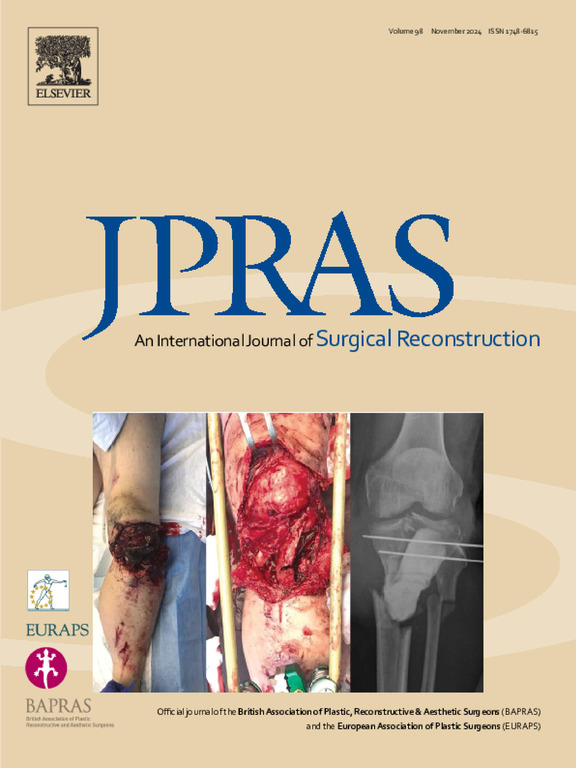大鼠多区穿支皮瓣窒息血管重构的动脉发生机制
IF 2.4
3区 医学
Q2 SURGERY
Journal of Plastic Reconstructive and Aesthetic Surgery
Pub Date : 2025-07-07
DOI:10.1016/j.bjps.2025.06.037
引用次数: 0
摘要
背景:多区域穿支皮瓣(MPF)内的阻塞血管重构与皮瓣的血液供应有着复杂的关系。本研究的目的是阐明这些阻塞血管重塑的血运重建机制。方法采用x线摄影和苏木精-伊红(HE)染色对阻塞区微血管形态进行定性和定量评价。Evans蓝色染料用于量化阻塞区I内阻塞动脉的血流速度,而激光多普勒血流成像仪用于评估血液灌注。免疫组织化学也用于评估与动脉形成机制相关的蛋白的表达。结果术后3d组在阻塞区1观察到多条真吻合动脉。小动脉密度无明显升高;而PO 3、5、7 d组小动脉最大直径均超过对照组(p < 0.05)。HE染色显示微血管密度降低,微血管扩张。动脉血流速度在PO 6 h开始显著升高(P<0.05),在PO 1 d达到峰值。缺血1 d血流灌注高于缺血6 h (p < 0.05)。TRPV4、Ephrin B2、CD11b、MMP-9、eNOS表达显著升高(p < 0.05)。结论血管新生可能是阻塞区阻塞动脉重构的关键机制。动脉新生和血管新生在阻塞区阻塞动脉重构中的作用相似。本文章由计算机程序翻译,如有差异,请以英文原文为准。
Arteriogenesis mechanism of choke vessel remodelling in multiterritory perforator flap in rats
Background
The remodelling of choke vessels within the multiterritory perforator flap (MPF) is intricately associated with the blood supply of the flap. The objective of this study was to elucidate the revascularization mechanism underlying the remodelling of these choke vessels.
Methods
Integument radiography and hematoxylin-eosin (HE) staining were utilised to qualitatively and quantitatively evaluate the microvascular morphology within the choke zones. The Evans blue dye was employed to quantify blood flow velocities in the choke arteries within choke zone I, while a laser Doppler blood flow imager was utilised to assess blood perfusion. Immunohistochemistry was also conducted to evaluate the expression of proteins associated with arteriogenesis mechanisms.
Results
In choke zone I, several true anastomotic arteries were observed in the 3d postoperation (PO) group. There was no significant increase in arteriolar density; however, the maximum calibre of arterioles in the 3 d, 5 d, and 7 d PO groups exceeded that of the control group (P<0.05). HE staining showed a decrease in microvessel density and dilation of the microvasculature. The arterial blood flow velocity began to significantly increase at 6 h PO (P<0.05) and reached its peak at 1 d PO. Blood perfusion was higher at 1 d PO than at 6 h PO (P<0.05). The expression of the TRPV4, Ephrin B2, CD11b, MMP-9 and eNOS increased significantly (P<0.05).
Conclusions
Arteriogenesis is likely the key revascularization mechanism involved in choke artery remodelling in choke zone I. Arteriogenesis and angiogenesis play similar roles in choke artery remodelling in choke zone II.
求助全文
通过发布文献求助,成功后即可免费获取论文全文。
去求助
来源期刊
CiteScore
3.10
自引率
11.10%
发文量
578
审稿时长
3.5 months
期刊介绍:
JPRAS An International Journal of Surgical Reconstruction is one of the world''s leading international journals, covering all the reconstructive and aesthetic aspects of plastic surgery.
The journal presents the latest surgical procedures with audit and outcome studies of new and established techniques in plastic surgery including: cleft lip and palate and other heads and neck surgery, hand surgery, lower limb trauma, burns, skin cancer, breast surgery and aesthetic surgery.

 求助内容:
求助内容: 应助结果提醒方式:
应助结果提醒方式:


